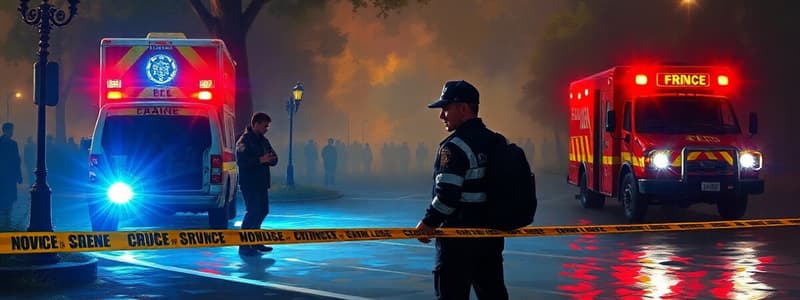Podcast
Questions and Answers
What should be the primary goal of an EMS provider at a crime scene?
What should be the primary goal of an EMS provider at a crime scene?
- Ensuring personal safety (correct)
- Providing patient care
- Collecting evidence for law enforcement
- Documenting the scene
Which of the following is an environmental indicator of violence?
Which of the following is an environmental indicator of violence?
- Threats
- Broken windows (correct)
- Shouting
- Aggressive behavior
Which action should an EMS provider take regarding weapons found at a crime scene?
Which action should an EMS provider take regarding weapons found at a crime scene?
- Document and photograph them
- Carefully move them to a safe location
- Immediately secure them for law enforcement
- Avoid touching them unless absolutely necessary for patient care (correct)
What is a key consideration when parking at a crime scene?
What is a key consideration when parking at a crime scene?
Which of the following is an example of a behavioral indicator of potential violence?
Which of the following is an example of a behavioral indicator of potential violence?
What should an EMS provider do if a hostile individual approaches at a crime scene?
What should an EMS provider do if a hostile individual approaches at a crime scene?
Who is responsible for scene security at a crime scene?
Who is responsible for scene security at a crime scene?
What should EMS providers do regarding their positioning at a crime scene?
What should EMS providers do regarding their positioning at a crime scene?
If police declare an area unsafe, what should EMS providers do?
If police declare an area unsafe, what should EMS providers do?
Which of these is a verbal indicator of violence?
Which of these is a verbal indicator of violence?
In domestic violence situations, why might victims be reluctant to speak freely?
In domestic violence situations, why might victims be reluctant to speak freely?
Which of the following is a warning sign that a scene may become dangerous?
Which of the following is a warning sign that a scene may become dangerous?
What should EMS providers do if they suspect the presence of hazardous substances at a drug-related incident?
What should EMS providers do if they suspect the presence of hazardous substances at a drug-related incident?
When should EMS providers enter an active shooter or hostage situation?
When should EMS providers enter an active shooter or hostage situation?
What does minimizing scene contamination involve?
What does minimizing scene contamination involve?
What should you do if you need to remove a patient from an active crime scene?
What should you do if you need to remove a patient from an active crime scene?
What should an EMS do when dealing with Drug-Related incident?
What should an EMS do when dealing with Drug-Related incident?
What is not a key consideration when operating at a Crime Scene?
What is not a key consideration when operating at a Crime Scene?
What should an EMS do with patient's clothing?
What should an EMS do with patient's clothing?
What happens if a hostage situation is not secured?
What happens if a hostage situation is not secured?
Flashcards
Indicators of Violence
Indicators of Violence
Signs that indicate a scene is unsafe or that violence is ongoing.
Environmental Indicators of Violence
Environmental Indicators of Violence
Gunshots, broken windows, blood, weapons, drug paraphernalia, gang-related graffiti.
Behavioral Indicators of Violence
Behavioral Indicators of Violence
Aggressive behavior, refusal to cooperate, threatening body language, unconscious individuals in unusual positions.
Verbal Indicators of Violence
Verbal Indicators of Violence
Signup and view all the flashcards
Warning Signs of Escalating Violence
Warning Signs of Escalating Violence
Signup and view all the flashcards
Scene Size-Up and Approach
Scene Size-Up and Approach
Signup and view all the flashcards
Maintaining Situational Awareness
Maintaining Situational Awareness
Signup and view all the flashcards
Interaction with Law Enforcement
Interaction with Law Enforcement
Signup and view all the flashcards
Preserving Evidence
Preserving Evidence
Signup and view all the flashcards
Exiting Safely
Exiting Safely
Signup and view all the flashcards
Domestic Violence Scenes
Domestic Violence Scenes
Signup and view all the flashcards
Active Shooter/Hostage Situations
Active Shooter/Hostage Situations
Signup and view all the flashcards
Drug-Related Incidents
Drug-Related Incidents
Signup and view all the flashcards
Crime Scene Awareness
Crime Scene Awareness
Signup and view all the flashcards
Study Notes
- EMS providers must prioritize personal safety while ensuring patient care at crime scenes
- It is critical to understand how to safely operate in high-risk environments, this will also ensure the integrity of the scene
Recognizing Indicators of Violence
- EMS providers must identify the signs that a scene is unsafe
Environmental Indicators
- Examples include gunshots, broken windows, or forced entry points
- Blood on the ground, walls, or furniture is another indicator
- Weapons in plain sight like knives, firearms, or blunt objects can provide cues
- Drug paraphernalia, evidence of substance abuse, or gang-related graffiti may occur at a crime scene
Behavioral Indicators
- Watch out for aggressive or erratic behavior from bystanders, patients, or suspects
- Note individuals who refuse to cooperate or display threatening body language
- Look for unconscious or unresponsive individuals in unusual positions, these indicate possible attack
Verbal Indicators
- Threats directed at EMS, police, or others on scene are key verbal indicators
- Shouting, screaming, or escalating conflict may occur
- Bystanders discussing potential harm to others or retaliation can signify danger
Warning Signs of a Potentially Dangerous Scene
- EMS providers must remain vigilant because a safe scene can rapidly turn volatile
- Sudden changes in demeanor of bystanders or family members can indicate a change
- Escalation in verbal threats or aggressive gestures may lead to violence
- Individuals reaching for pockets, waistbands, or concealed areas may have weapons
- Unexpected arrivals of new individuals who could be hostile should be noted
- Law enforcement actively drawing weapons or assuming defensive postures can signify danger
Steps to Protect Yourself at a Crime Scene
- Waiting for law enforcement clearance before entering crime scenes, especially those involving weapons or violence, is essential
Scene Size-Up and Approach
- Park away from the immediate scene to allow for quick egress, if needed in the future
- Keep emergency lights to a minimum in high-risk areas to avoid drawing attention to yourself
- Cautiously approach while being aware of potential hiding spots, or ambush points
Maintaining Situational Awareness
- Continuously scan for threats, weapons, or hostile individuals.
- Communicate effectively by working closely with law enforcement and keeping the team informed
- Control positioning, avoiding turning your back on unknown individuals or unsecured areas
- Limit distractions by focusing on both the patient, and the surroundings
Interaction with Law Enforcement
- Follow instructions given by police officers because they are responsible for scene security
- Avoid touching/moving weapons, evidence, or any forensic material unless necessary for patient care
- Coordinate with law enforcement to ensure safety when removing a patient from an active crime scene
Preserving Evidence While Providing Care
- Minimize scene contamination by avoiding unnecessary movement of objects or blood evidence
- Enter and exit using a direct path
- Carefully document scene conditions, the patient's position, and any interactions with law enforcement
- Avoid altering the patient’s clothing or appearance unless required for medical intervention
Exiting the Scene Safely
- Leave immediately if the scene becomes dangerous
- Follow the police evacuation instructions, if given
- Create distance, use barriers, and request law enforcement assistance if approached by a hostile individual
Special Situations
- It is important to follow correct protocol in special situations
Domestic Violence Scenes
- These scenes can be extremely volatile with the suspect potentially still present
- Always wait for law enforcement clearance before entering
- Victims may be reluctant to speak freely out of fear of their abuser
Active Shooter or Hostage Situations
- Never enter unless law enforcement has secured the scene
- Stage in a safe area until directed to enter
- Anticipate multiple casualties and chaotic conditions with needed medical assistance
Drug-Related Incidents
- Drug use and trafficking increases the risk of violence
- Be aware of hazardous substances like fentanyl, which can cause accidental exposure
- Never needlessly handle unknown substances and notify police of any suspicious materials involved
Conclusion
- Crime scene awareness is essential for every EMS provider
- Recognize indicators of violence, stay alert for warning signs, and follow safety measures for self-preservation while ensuring patient care
- Prioritize personal safety, coordinate with law enforcement, and thoroughly document everything to maintain medical and legal integrity
Studying That Suits You
Use AI to generate personalized quizzes and flashcards to suit your learning preferences.



